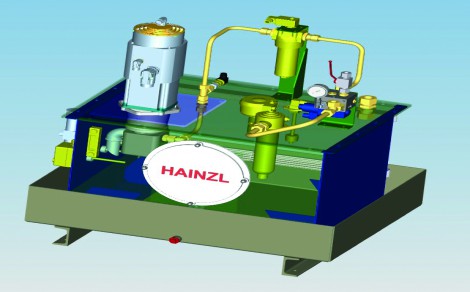A focus on energy efficiency

Kollmorgen has developed a ready-made drive solution for hydraulics applications for the S700 series’ servo drives. The new technology improves the energy efficiency of applications that need the high-power density associated with hydraulics. Two other benefits are control precision and longevity.
The pressure and volume flow control for hydraulic applications is generally achieved with the help of variable displacement pumps. Standard solutions use comparatively primitive asynchronous motors for this, which drive the variable displacement pumps. A control system responsible for ensuring compliance with setpoints, is connected to this arrangement. This classic setup is controlled via pressure sensors and by controlling pressure levels and flow speeds within broadly defined - and therefore imprecise - control ranges. Energy efficiency and noise emissions are two further disadvantages as asynchronous machines generate a lot of reactive power and more noise compared with synchronous motors.
By contrast, the Kollmorgen solution copes with the varying pressure and flow rate requirements associated with hydraulic applications thanks to the speed of the synchronous servo motor—so not by means of valves. The S700 servo drive assumes control of the two parameters in conjunction with the synchronous servo motor and a fixed displacement pump. It delivers the same volume with each rotation. As a result, the reference variable for control purposes becomes speed alone.
Independent pressure control in the servo drive
The setup associated with this servo drive solution devised for hydraulics applications envisages that the S700 intelligent servo inverter will assume control on a self-sufficient basis. The control system connected via field bus or analog signal only specifies the values for pressure and volume, with the servo drive then ensuring precise compliance with these through the speed. "With a sampling rate of 16 kHz, we are able to achieve fast and precise control of speeds, which gives ideal values for pressure and volume purposes," explains Kollmorgen development engineer Georg Jaskowski. The software in the S700 servo drive from Kollmorgen also opens the possibility of efficiency compensation due to higher pump speeds. "The same applies to linear interpolations, with the effect being to even out and therefore absorb vibrations and pulsations to great effect," points out Georg Jaskowski. Another benefit is the option, in actual practice, to save target pressure and volume levels via profiles or ramps in the drive in the form of prescriptions and make these immediately accessible and available to the control system.
The various benefits outlined above are used by the Austrian company Hainzl to engineer complete hydraulics solutions in the low-to-medium power range—for tasks ranging from plastics processing to handling technology. According to Peter Schrenk, head of fluids technology at Hainzl, the benefits of electro hydraulics really come into their own in the 1 to 20 kW range. As well as this, a case can still be made for centralized systems.
-
PPMA 2025
23 September, 2025, 9:30 - 25 September, 2025, 16:00
NEC, Birmingham UK -
Advanced Engineering Show 2025
29 October, 2025, 9:00 - 30 October, 2025, 16:00
NEC, Birmingham UK










